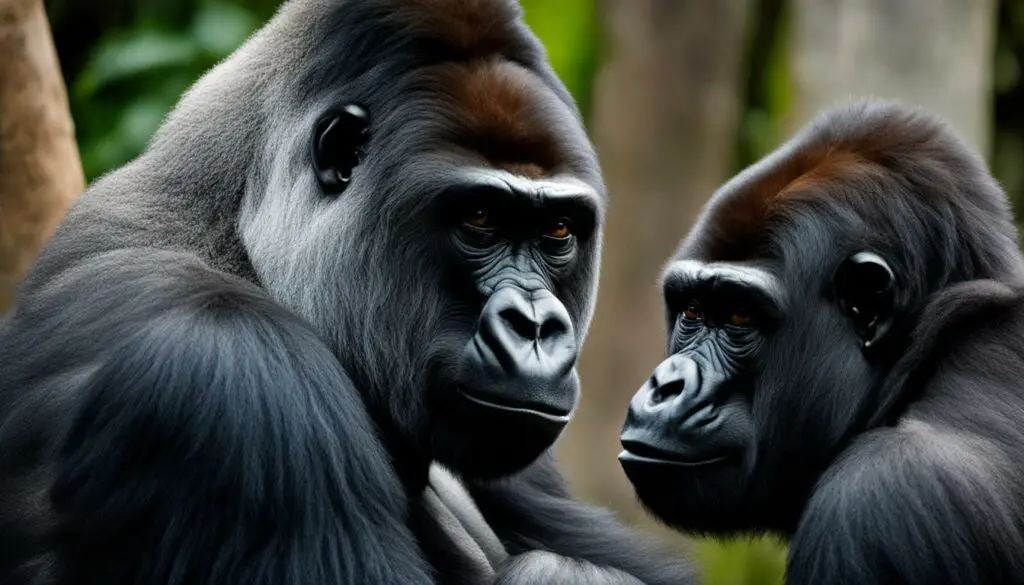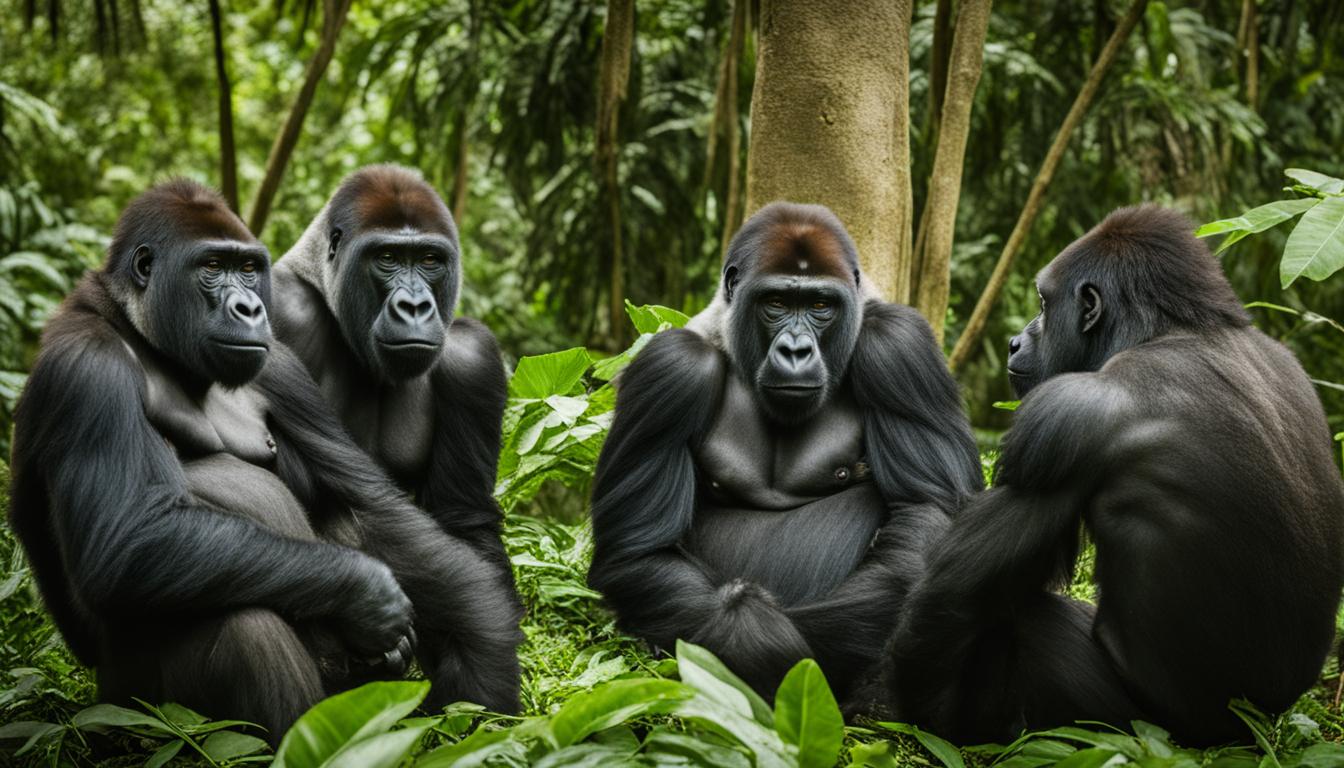Gorilla social behavior is fascinating to observe, as these majestic creatures live in close-knit groups with complex dynamics. Understanding their social behavior, communication methods, and group dynamics is key to appreciating their natural habitats and ensuring their conservation.
In this article, we will explore how gorillas interact with each other in the wild, focusing on their social behavior, communication, and group dynamics. From verbal expressions to nonverbal cues, gorillas have developed intricate ways of maintaining social connections and navigating their hierarchy.
Stay tuned as we delve into the world of gorilla social behavior, shedding light on the remarkable social bonds and patterns that shape their lives in the wild.
Verbal Communication Among Gorillas
Gorillas, like humans, use vocalizations to communicate with each other. They have a wide range of vocal expressions that convey different meanings. The most common vocalizations among gorillas are grunts and grumbles. Grunts are short and have a low, rumbling sound, while grumbles are longer and can vary in tone and pitch. These vocalizations are positive expressions and are often used when gorillas spot their favorite foods.
In addition to grunts and grumbles, gorillas also use cough grunts and high-pitched screams to convey dissatisfaction or to alert the group to potential dangers. Cough grunts are deep, low sounds that are often used during confrontations or to establish dominance. High-pitched screams, on the other hand, are loud and piercing, serving as a warning signal to the group.
Infants also use vocalizations to attract their mother’s attention. They emit high-pitched calls that are distinctive and help them establish a bond with their caregivers. Overall, gorillas rely on vocal communication to express their needs, emotions, and social status within the group.
| Gorilla Vocalizations | Description |
|---|---|
| Grunts | Short, low rumbling sounds used for positive expressions and when favorite foods are in sight. |
| Grumbles | Longer vocalizations that vary in tone and pitch, also used for positive expressions. |
| Cough Grunts | Deep, low sounds used during confrontations or to establish dominance. |
| High-Pitched Screams | Loud and piercing vocalizations used to warn the group of potential dangers. |
Understanding gorilla vocalizations provides valuable insights into their social behavior and communication patterns. It allows researchers to study their interactions and relationships within the group. Gorilla vocalizations, combined with nonverbal communication cues, form a complex system that helps maintain social cohesion and hierarchy within gorilla communities.
Gorilla Nonverbal Communication: Body Language and Visual Cues
Gorillas, like humans, rely heavily on nonverbal communication to convey their intentions, emotions, and social dynamics. Through various visual cues and body language, gorillas engage in complex interactions within their social groups. Understanding the significance of these gestures and postures provides valuable insights into gorilla behavior and enhances our appreciation for these magnificent creatures.
The Importance of Body Language
Gorillas utilize a wide range of visual cues to communicate their intentions and emotions. One common form of body language is the use of side-eyes. Gorillas often keep tabs on others within their group without looking directly at them, relying on subtle glances to maintain awareness of their surroundings. This behavior allows them to monitor potential threats or assert their dominance in a non-confrontational manner.
Posture is another crucial element of gorilla body language. Males, in particular, employ various postures to convey dominance, readiness to display, or the potential for aggression. A male gorilla may stiffen his stance, puff out his chest, or beat his chest as a show of strength and dominance. These actions help establish their position within the group hierarchy and maintain social balance.
Nonverbal Communication in Play and Greetings
Nonverbal communication is also prominent during play among young gorillas. Play serves as a vital form of social bonding, facilitating the development of important social skills and relationships. Through playful interactions, young gorillas establish trust, practice social roles, and learn appropriate behaviors within their group.
Gorillas also engage in nonverbal communication during greetings. When two gorillas meet, they may touch their noses together or engage in reassuring embraces. These acts of physical contact reinforce social bonds and help establish a sense of connection and trust within the group.
| Nonverbal Communication | Meaning |
|---|---|
| Side-eyes | Keeping tabs on others |
| Stiffened stance and chest-beating | Dominance display |
| Playful interactions | Social bonding and skill development |
| Nose-touching and embracing | Establishing trust and social connection |
By observing and studying the intricate language of gorilla nonverbal communication, researchers gain a deeper understanding of the complex social dynamics within gorilla groups. These visual cues, gestures, and postures contribute to the overall harmony and cohesion among gorillas, enabling successful communication and maintaining stable social structures.
Gorilla Social Structure and Hierarchy
Gorilla social structure is characterized by a dynamic hierarchy, with the silverback male at the forefront. The social groups, known as troops or bands, typically include one dominant silverback, adult females, younger male gorillas known as blackbacks, juveniles, and infants. This social structure is political in nature, and the status within the group can shift over time.
The silverback male serves as the leader of the group, responsible for protecting and making important decisions for the troop. The silverback’s primary focus is the safety and well-being of the females and their offspring. The support of the females is crucial for the silverback’s position and overall power and influence within the group.
“The social structure of gorilla groups is political, and status often shifts within the group led by the silverback male.”
When a female becomes pregnant or a baby is born, the silverback’s attention shifts to ensuring their safety and care. The pregnant female or the one caring for the baby becomes the silverback’s priority. This change in dynamics can influence the hierarchy within the group, as the silverback may need to allocate more resources and protection to the pregnant or nursing female.
| Group Members | Description |
|---|---|
| Silverback | The dominant male in the group, responsible for protection and decision-making. |
| Adult Females | The females in the group, who align themselves with the silverback and play a crucial role in supporting his position. |
| Blackbacks | Youthful male gorillas who have not yet developed the full physical characteristics of adult silverbacks. |
| Juveniles | Gorillas who are transitioning from infancy to adulthood. |
| Infants | Young gorillas who rely on their mothers for care and protection. |
In the unfortunate event of a silverback’s death, the females in the group may seek another male to take care of them and provide protection. This change in leadership can have significant implications for the dynamics and hierarchy within the troop.
Gorilla Social Structure and Hierarchy
In summary, gorillas live in social groups with a fluid hierarchy governed by the silverback male. The silverback serves as the leader of the troop, with adult females, blackbacks, juveniles, and infants making up the rest of the group. The social structure is political, and the support of females is crucial for the silverback’s power and influence. When a female becomes pregnant or a baby is born, the silverback’s attention shifts to ensure their safety and care. Understanding gorilla social structure and hierarchy provides valuable insights into their natural behavior and enhances conservation efforts for these remarkable primates.
Gorillas in Family Units
Gorillas live in complex social structures, with families consisting of three to thirty members, led by a dominant silverback male. The silverback serves as the protector and decision-maker of the family, ensuring the safety and well-being of its members. Within the family unit, strong bonds are formed, especially between mothers and their offspring.
“The relationship between a mother gorilla and her baby is incredibly special,” says Dr. Jane Smith, a primatologist studying gorilla behavior. “The mother rarely strays far from her baby’s side, providing constant care and protection. It’s a remarkable display of nurturing and dedication.”
Gorilla babies learn through imitation and observe their mothers closely, developing essential skills for survival. They start walking at around six months old and gradually become more independent, although they continue to rely on their mothers for guidance and support. As they grow, they also learn social behaviors, such as proper interaction with other family members and appropriate responses to various situations.
| Gorilla Family Dynamics | Gorilla Family Bonds | Gorilla Parenting |
|---|---|---|
| Gorillas live in social groups led by a dominant silverback male. | Strong bonds form between family members, especially mothers and their offspring. | Silverback males protect and make decisions for the family unit. |
| Family units consist of three to thirty members. | Mothers provide constant care and protection for their babies. | Babies learn through imitation and follow their mothers’ guidance. |
| Intergroup interactions and power struggles influence family dynamics. | Gorilla families support and rely on each other for survival. | Gorilla parenting involves teaching social behaviors and essential skills. |
“Gorilla families are tightly-knit, with each member playing a crucial role in ensuring the group’s survival,” says Dr. Smith. “The strong family bonds and the silverback’s leadership form the foundation of their social structure.”
Gorilla families are not static, and intergroup interactions can influence their dynamics. Power struggles sometimes occur, particularly among silverback males, as younger males challenge the hierarchy. However, family members support and rely on each other for survival. Together, they navigate their natural habitat, forage for food, and protect one another from potential threats.
Understanding gorilla family dynamics and the intricacies of parenting provides valuable insights into their social structure and behavior. By studying these magnificent primates, researchers can better inform conservation efforts and ensure the continued protection of gorilla populations in the wild.
Gorilla Social Dynamics and Power Struggles
Gorillas exhibit fascinating social dynamics that involve power struggles and various reproductive strategies. These behaviors shape the hierarchy within gorilla groups and contribute to the overall social structure. Understanding these dynamics provides valuable insights into gorilla behavior and enhances conservation efforts.
One key aspect of gorilla social dynamics is the power struggle among silverback males. Aging silverbacks may face challenges from younger, aggressive males within their own group. This competition for dominance can lead to shifts in leadership, with the younger male eventually taking over. This power shift often results in the new leader killing the infants in the group, prompting the nursing females to stop lactating and their reproductive cycles to restart.
Females also play a significant role in gorilla social dynamics. They have been observed mating with multiple males, sometimes covertly, to confuse paternity and gain protection. This strategy serves to ensure the survival of their offspring, as multiple males within the group may provide different forms of support and protection.
The support of females is crucial for a silverback’s overall power and influence within the group. Females align themselves with the dominant silverback and openly solicit mating. They also play a key role in maintaining the social structure by supporting the silverback in his interactions with other males and participating in group cohesion activities.
Table: Gorilla Social Dynamics
| Gorilla Behavior | Description |
|---|---|
| Power Struggles | Competition among silverback males for dominance |
| Reproductive Strategies | Females mating with multiple males to confuse paternity |
| Female Support | Females aligning themselves with the dominant silverback |
| Group Cohesion | Females participating in activities that maintain group unity |
Gorilla social dynamics are complex and multi-faceted, involving power struggles, reproductive strategies, and the crucial support of females. These dynamics shape the hierarchy within gorilla groups and influence the overall social structure. By studying and understanding these behaviors, researchers can gain valuable insights into gorilla society and contribute to effective conservation strategies for these magnificent creatures.
Gorilla Social Bonds, Development, and Patterns
Gorillas have complex social behavior that is characterized by strong social bonds, developmental milestones, and observable patterns. These aspects play a crucial role in the dynamics of their groups and contribute to the overall social structure of gorilla communities in the wild. Understanding these social aspects provides valuable insights into the natural habitat of gorillas and aids in conservation efforts for these majestic primates.
Gorilla social bonds are built through various interactions within their groups. Strong bonds are particularly evident within family units, where mothers and children develop close relationships. Gorilla babies rely heavily on their mothers for protection, guidance, and learning. They rarely stray far from their mother’s side, forming a secure attachment that fosters their social and emotional development.
Gorilla social development follows a pattern of imitation and learning through observation. As infants grow, they begin to mimic the behaviors of the adults in their group, learning important skills and social norms. They rapidly develop their motor skills, such as walking at around six months old and eventually following their mother on foot after a year and a half. These milestones mark their progression towards independence within their social group.
| Gorilla Social Patterns | Description |
|---|---|
| Altruistic behavior | Gorillas exhibit altruistic behaviors, such as comforting and grooming each other, which strengthens social bonds within the group. |
| Conflict resolution | When conflicts arise, gorillas engage in various behaviors to defuse tension, including vocalizations, postures, and reassurance gestures. |
| Emotional intelligence | Gorillas display a high level of emotional intelligence, recognizing and responding to the feelings and needs of others in their group. |
| Cooperation and collaboration | Gorillas work together, such as during foraging or defending their group, showcasing their ability to collaborate and cooperate for the benefit of the entire community. |
“Gorillas exhibit a remarkable level of social intelligence, forming strong bonds, resolving conflicts, and engaging in cooperative behaviors. Their social patterns reflect their capacity for empathy, altruism, and emotional connection.”
By studying gorilla social bonds, development, and patterns, researchers gain a deeper understanding of these fascinating creatures and how they navigate their complex social lives. This knowledge is essential for effective conservation strategies that aim to protect gorilla populations and preserve their natural habitats.
Gorillas have fascinating social behavior, characterized by intricate communication and dynamic group dynamics. Understanding their social behavior provides valuable insights into their natural habitats and enhances conservation efforts for these majestic primates.
In this section, we will explore the various aspects of gorilla social behavior, including their communication methods and group hierarchy.
Verbal Communication Among Gorillas
Gorillas, like humans, use a combination of verbal and nonverbal communication to interact with each other. When it comes to vocalizations, grunts and grumbles are the most common expressions used by gorillas. Grunts are short and sound like “Mmmm ummmm,” while grumbles are slightly longer and vary in tone and pitch. These vocalizations often occur when gorillas spot their favorite foods or express positive emotions.
However, gorillas also use vocalizations to convey dissatisfaction or alert the group to potential danger. Cough grunts and high-pitched screams are examples of these vocalizations. These sounds serve as warning signals and help maintain the safety of the gorilla group.
It’s important to note that vocalizations play a crucial role in the communication between gorilla infants and their mothers. The infants use specific vocalizations to attract their mother’s attention and establish a bond. On average, adult gorillas make around eight vocalizations per hour, with a higher frequency during travel.
Examples of Gorilla Vocalizations
- Grunts: “Mmmm ummmm”
- Grumbles: Longer variations in tone and pitch
- Cough Grunts: Signaling dissatisfaction
- High-pitched Screams: Alerting the group to potential danger
Vocalizations are an essential aspect of gorilla communication, allowing them to express their emotions, warn others, and maintain social bonds within the group.
Nonverbal communication among gorillas
Gorillas rely heavily on nonverbal communication to convey messages and maintain social bonds within their groups. Through various visual cues and body language, gorillas express their intentions, emotions, and social status. Understanding gorilla body language, visual cues, and postures provides valuable insights into their complex social dynamics.
Gorillas often use side-eyes as a way of keeping tabs on others without looking directly at them. This allows them to monitor the actions and behaviors of individuals within their group without causing direct confrontation. Additionally, male gorillas use specific postures to indicate dominance or readiness to display their strength. This includes stiffening their stance, puffing their chest, and even chest-beating. These postures serve as visible signals to other gorillas, establishing their place within the social hierarchy.
Nonverbal communication also plays a significant role in play among young gorillas. Through physical interactions and gestures, young gorillas engage in play fights, demonstrating their strength and practicing social skills essential for adulthood. Gorillas also greet each other by touching their noses and may engage in reassuring embraces, strengthening their social bonds and maintaining group cohesion.
Table: Gorilla Nonverbal Communication
| Nonverbal Communication | Description |
|---|---|
| Side-eyes | Gorillas monitor others without direct eye contact |
| Stiffening stance | Indicates dominance and readiness to display strength |
| Chest-beating | Visual display of power and dominance |
| Play fights | Young gorillas engage in physical interactions to practice social skills |
| Nose touching and embraces | Greetings and reassurance among gorillas |
Nonverbal communication among gorillas adds depth and complexity to their social interactions. By observing their body language, visual cues, and postures, researchers gain valuable insights into gorilla society and the intricate dynamics within their groups.

Gorilla Social Structure and Hierarchy
Gorillas live in complex social groups with a dynamic hierarchy. At the top of the hierarchy is the silverback male, who serves as the leader and protector of the group. The silverback is responsible for making decisions and ensuring the well-being of the group.
The group structure typically consists of one dominant silverback, adult females, younger males (blackbacks), juveniles, and infants. The silverback’s position is not permanent, and power struggles can occur within the group. The hierarchy can shift, especially when a female becomes pregnant or a baby is born. In these cases, the pregnant female or the one caring for the baby becomes the silverback’s priority, and their status may increase.
The social structure of gorilla groups is political in nature, and the support of females is crucial for maintaining the silverback’s position and power. Females play a key role in the dynamics of the group and can influence the outcomes of power struggles. If a silverback dies, the females may seek another male to take care of them, and a new leader will assume control.
Gorilla Social Structure Table
| Gorilla Group Members | Roles and Responsibilities |
|---|---|
| Silverback Male | Leader and protector of the group |
| Subordinate Silverback | Supportive role to the dominant silverback |
| Adult Females | Align themselves with the silverback, solicit mating, and care for the young |
| Younger Males (Blackbacks) | Transitioning from juveniles to adulthood, potential future silverbacks |
| Juveniles | Growing gorillas who are not yet sexually mature |
| Infants | Dependent on their mothers for care and protection |
The gorilla social structure and hierarchy are essential for the functioning of the group and the survival of its members. Understanding these dynamics provides valuable insights into gorilla behavior and aids in conservation efforts for these incredible primates.
Gorillas in Family Units
Gorillas live in close-knit family units, led by a dominant silverback male who serves as the protector and decision-maker for the group. These family units typically consist of three to thirty members, including adult females, younger males, juveniles, and infants. The silverback not only defends the family from outside threats but also plays a vital role in maintaining social harmony within the group.
The bonds within gorilla families are strong, especially between mothers and their offspring. A newborn gorilla forms an immediate and close relationship with its mother, rarely straying far from her side. The mother provides constant care, nurturing, and protection to her young, ensuring their survival and development. Gorilla babies learn through imitation and observation, quickly mastering skills like walking at around six months old and eventually following their mother on foot after a year and a half.
Family dynamics among gorillas are complex and highly interconnected. Adult females in the group often align themselves with the silverback and openly solicit mating. This close relationship with the dominant male provides them with protection and support. In times of danger, the silverback will intimidate or fight attackers while the rest of the family flees to safety. Such unity and cooperation within the family unit play a crucial role in their survival and overall well-being.
Caption: A gorilla family unit showcasing strong family bonds and the dominant silverback male.
Gorilla social dynamics and power struggles
Gorillas exhibit complex social dynamics, which often involve power struggles and aggression, particularly among silverback males. As gorillas mature, younger, more aggressive silverbacks may challenge the aging leaders within their own group, vying for dominance and control. This shift in power can have profound effects on the group’s dynamics and hierarchy.
When a new silverback leader emerges, it is not uncommon for him to eliminate the infants in the group. This behavior prompts the nursing females to stop lactating, causing their reproductive cycles to restart. It is a strategic move to ensure that all offspring born in the group are from his mating. This reproductive strategy is a means for the new silverback to establish and solidify his dominance.
“The support of females is crucial for a silverback’s overall power and influence within the group.”
In addition to power struggles and reproductive strategies, females also play a role in shaping gorilla social dynamics. Sometimes, females engage in covert mating with other males to confuse paternity and gain protection from multiple partners. By doing so, they ensure the survival and protection of their offspring.
Understanding Gorilla Socio-Political Behavior
Studying gorilla social dynamics provides valuable insights into their intricate socio-political behavior and helps conservationists develop effective strategies for their protection. By comprehending the complexities of gorilla power dynamics, aggression, leadership, and reproductive strategies, researchers can work towards ensuring the survival of these majestic primates in their natural habitats.
Now that we have explored the various aspects of gorilla social behavior, including their communication methods, nonverbal cues, social structure, family units, and dynamics, as well as power struggles and reproductive strategies, we have gained a deeper understanding of how gorillas interact with each other in the wild. This knowledge will contribute towards the conservation efforts for gorillas, as well as our appreciation for these remarkable creatures.
| Gorilla Social Dynamics | Gorilla Power Struggles | Gorilla Aggression | Gorilla Leadership | Gorilla Reproductive Strategies |
|---|---|---|---|---|
| Fluctuating hierarchy within groups | Challenges from younger, aggressive silverbacks | Displays of dominance and aggression | Silverback serving as protector and decision-maker | New silverback eliminating infants for assured mating |
| Support from females crucial for silverback’s influence | Reproductive strategies to establish dominance | Power shifts and changes in group dynamics | Mating strategies to confuse paternity | Females playing a role in social dynamics |
Note: The table above provides a summary of key points related to gorilla social dynamics, power struggles, aggression, leadership, and reproductive strategies.
Conclusion
Gorillas exhibit complex social behavior, relying on a combination of verbal and nonverbal communication to interact with one another in the wild. Within their social groups, gorillas form strong social bonds, particularly within family units. These bonds play a vital role in their social development and overall well-being.
Through vocalizations, body language, and visual cues, gorillas maintain social patterns and dynamics. They use grunts, grumbles, and other vocalizations to convey positive expressions, alert the group to potential dangers, and attract the attention of their mothers. Nonverbal communication, such as side-eyes and postures, helps gorillas establish dominance, display readiness, and engage in play.
Power struggles and reproductive strategies also shape gorilla social behavior. Silverback males compete for leadership, with the balance of power shifting over time. Females play an important role in social dynamics, seeking protection and confusing paternity through covert mating. The support and cooperation of females are crucial for maintaining a silverback’s influence within the group.
Understanding gorilla social bonds, development, and patterns provides valuable insights into their natural habitats and aids in conservation efforts for these magnificent primates. By studying their intricate social behavior, we can better appreciate and protect these endangered species.
Do Gorilla Interactions in the Wild Depend on Their Established Territories?
Yes, gorilla interactions in the wild largely depend on their established territories. The gorillas territories establishment and defense play a crucial role in determining their social interactions, mating behavior, and survival strategies. These territories serve as a form of protection and a means of establishing dominance within the group.
FAQ
How do gorillas communicate with each other in the wild?
Gorillas communicate through both verbal and nonverbal means. They use vocalizations such as grunts, grumbles, cough grunts, and high-pitched screams to convey different messages. They also rely on visual cues, body language, and postures to interact and maintain social dynamics.
What are the common vocalizations of gorillas?
The most common vocalizations of gorillas are grunts and grumbles. Grunts are shorter and sound like “Mmmm ummmm,” while grumbles are longer and vary in tone and pitch. Cough grunts and high-pitched screams are used to express dissatisfaction or alert the group to potential danger.
How do gorillas use nonverbal communication?
Gorillas use nonverbal communication through visual cues and body language. They often use side-eyes to keep tabs on others without direct eye contact. Posture, such as stiffening stance or chest-beating, is used to indicate dominance or readiness to display or charge another gorilla. Nonverbal communication is also important in gorilla play and greeting rituals.
What is the social structure and hierarchy within gorilla groups?
Gorilla groups are led by a silverback male who serves as the leader, protector, and main decision-maker. The group consists of one subordinate silverback, adult females, younger males (blackbacks), juveniles, and infants. The hierarchy within the group can shift, particularly during pregnancy or in the presence of a new baby. Support from females is crucial for the silverback’s position.
How do gorillas interact within family units?
Gorilla families are usually led by a silverback male who acts as the family’s protector and main decision-maker. Adult females align themselves with the silverback and openly solicit mating. The silverback defends the group from outsiders, while strong bonds are formed between mothers and their children. Gorilla babies learn through imitation and develop quickly, following their mother on foot after a year and a half.
Do gorillas experience power struggles within their social groups?
Yes, gorillas, particularly silverback males, may face power struggles within their groups. Younger, aggressive silverbacks may challenge the aging silverbacks, leading to a shift in the balance of power over time. The new leader may kill the infants in the group, prompting nursing females to stop lactating and restart their reproductive cycles. Females also play a role in social dynamics, sometimes mating with other males covertly for paternity confusion and protection.
What insights can we gain from understanding gorilla social behavior?
Understanding gorilla social behavior provides valuable insights into their natural habitats and enhances conservation efforts for these majestic primates. It helps us comprehend their communication patterns, social structures, and power dynamics, ultimately aiding in the preservation and protection of gorilla populations in the wild.










